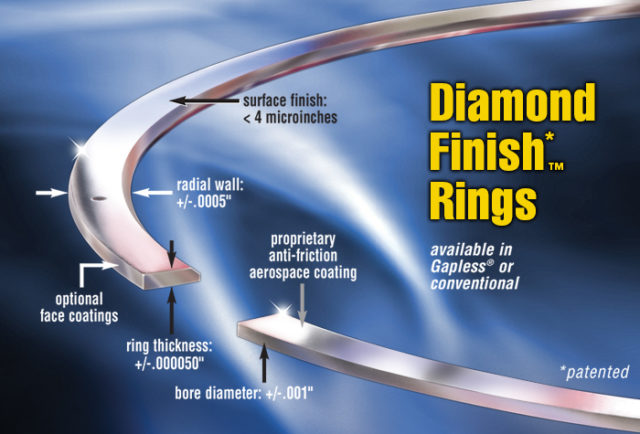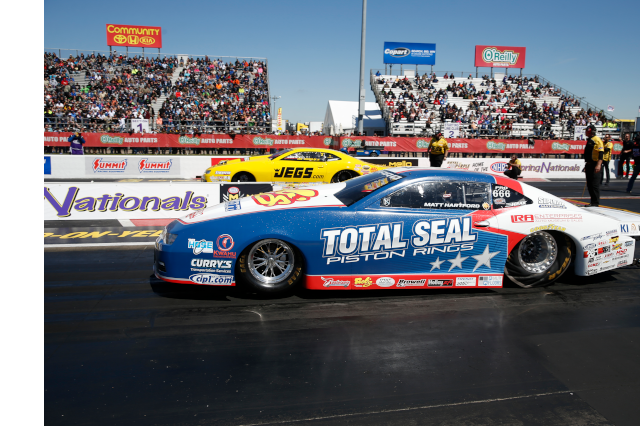Total Seal – Diamond Finish Rings
It Takes a Diamond-Like Finish
Whether you’re building an engine for your weekend hot rod or a NASCAR Cup car, the goal of the piston rings remains the same; seal the combustion gases into the area above the piston. This of course over-simplifies the process immensely, but the overall goal of minimizing leakage past the top ring is paramount to the performance of every internal combustion engine no matter what its use.
At the top of the motorsports pyramid however, there are more requirements for piston rings to achieve. Lightweight materials, reduced friction, conforming to the cylinder walls and endurance through the highest demands literally put a lot of pressure on the rings. This is where Total Seal’s Diamond Finish Ring Series shines.
To really understand the importance of the surface of the ring, as well as that of the groove on the piston, you need to think microscopic. If you zoom in on the finish of a typical ductile iron piston ring, the surface looks like a sawtooth which results in leakage areas, albeit, tiny areas. The axial thickness of a Diamond Finish ring is held at +/- .000050-inch (that’s fifty-millionths of an inch) compared to a typical production ring which are about +/-.0005-inch.

When it comes to the smoothest, flattest surface of a piston ring, Total Seal’s Diamond Finish series delivers. The surface finish along is measured at less than 4-microinches, plus they’re extremely lightweight.
As for the weight of the rings, lighter rings have a direct effect on the acceleration of an engine which is a benefit for race teams when it comes getting the engine rpm to the sweet spot. For example, a typical .043-inch by .155-inch ring weighs 9.5 grams. A Diamond Finish .027mm ring weighs only 4.7 grams! Also, a thinner ring can conform to the cylinder wall better while also reducing friction as another way to improve the sealing and efficiency of an engine.
Aerospace materials, combined with Total Seal’s patented manufacturing processes allow them to produce a surface roughness of less than 4-microinches. This smooth surface seals to the piston ring flank creating the tightest seal possible. And where there’s a tight seal, there will be improved efficiencies. Another area that can be improved is through the use of advanced friction reducing coatings such as a PVD coating.

Total Seal’s Vice President campaigns a competitive NHRA Pro Stock Car so they really walk the walk and talk the talk when it comes to racing.
PVD stands for Physical Vapor Deposition which is a process that deposits a thin layer of high density material to another surface. In the case of a stainless piston ring, it is placed into a vacuum where the material is blasted into the stainless at twice the speed of sound creating a durable friction reducing coating that will not wear off.
If a high level race engine is in your future, there’s never been a better time to step up to a set of Diamond Finish rings as Total Seal now offers their premiere rings in sets! The Ring Sets include a 0.8mm top and second ring paired with 3mm oil rings. For more information, contact the experts at Total Seal at 623-587-7400 or look them up on the web at totalseal.com
COMPANY DETAILS |
|
|
|
Company |
Total Seal |
|
Website |
|
|
Connect |
 
|
|
|
|
|
Phone |
(800) 874-2753 |
|
Address |
22642 North 15th Avenue |
|
Phoenix, Arizona 85027 |
ABOUT Total Seal®
In late 1999 we moved into our new 32,000 square foot facility in Phoenix, Arizona. It houses the latest in research and development equipment, manufacturing machinery and technology focusing on developing and manufacturing piston rings for any and all applications.Our rings continue to show up on the world’s fastest, from NASCAR and IndyCar, from marine to drag racing, oval track to off road – nobody builds piston rings that seal better than Total Seal.

